Sideboard Plans
Always go in with a plan. Magic will go better for you if you have a blueprint in your mind for how you're going to win the game; how you're going to beat your opponent's strategy; and, as we'll discuss today, how to best sideboard to do so. At the end, I'll preview a handful of potential new sideboard cards that will be printed in Dragons of Tarkir.
For a refresher on sideboarding, see "The Sideboard."
Why Have a Set Plan?
The topic of sideboard plans is actually a rather controversial one. Many of my colleagues recommend against having firm sideboard plans, instead emphasizing improvisation and flexibility. In my opinion, this advice does more harm than good.
It's never good to limit your options, and indeed, there will come times when you should deviate from your original sideboarding plan. However, creating a sideboard plan is a way to unify your deck construction with your in-match decisions and to ensure that they serve one another as well as possible. Your card choices are made based on what you intend to do during sideboarding, and what you do during sideboarding fits with your card choices.
Put a different way, having a sideboard plan means seeing the big picture, instead of focusing on questions one at a time, independent from one another.
It's easy to make mistakes when you don't think about your sideboard plans ahead of time. Let's say you're playing a black deck, and you decide to put three Pharika's Cures and three Bile Blights in your sideboard, because these cards are good against aggressive red decks. In Round 2 of the tournament, you find yourself sideboarding against an aggressive red deck and realize that your deck simply has too much removal. Now you either have to leave some of your Cures and Blights on the sidelines, or else start cutting your main-deck cards that were good for the matchup anyway! This inconvenience could've been easily avoided!
What could also happen, and is even worse, is that you might wind up compounding your deck-building mistake by mis-sideboarding in the tournament. Perhaps you make the obvious decision to trim some of your Read the Bones and your expensive cards for the Pharika's Cures and Bile Blights against your aggressive red opponent. But now you've lost the late-game power that was the original strength of your deck. You kill your opponent's first flurry of creatures only to find yourself flooding out and losing a long game. Because you weren't thoughtful enough about your sideboarding, you wound up losing a match that you might've otherwise won!
How Many Cards Will You Bring In and Take Out?
The above example highlights the biggest risk of not planning your sideboarding ahead of time. This is the risk that you won't have the same number of cards to sideboard out as the number of cards you have to sideboard in.
For each matchup, it's helpful to go through your main deck and count the number of cards that are dispensable and that you're unhappy with. This is a good target for how many sideboard cards you ought to have for the matchup. To return to the example of the black deck against the red deck, you might go through your main deck and decide that you can afford to trim one expensive card and two Read the Bones (leaving two to maintain your strength in the late game). Now you know that three cheap removal spells is an ideal number to have in your sideboard.
Next, you go through and count the number of removal spells that you want to sideboard out against a creature-light control deck. You'll want to cut six removal spells (leaving three Hero's Downfalls to kill Planeswalkers and as insurance against a surprise creature off the opponent's sideboard). Now you know that you need to find six non-removal sideboard cards so you don't have any dead weight when you play against a control deck.
If you do this preliminary planning in advance of the tournament, you'll have a better-tuned deck, and you'll make fewer mistakes during sideboarding.
Sideboard for the Matchup, Not for the Card
You enter your weekly local tournament with a white deck. Playing against a red deck, the game drags out and your opponent casts Outpost Siege, naming Khans. Turn after turn goes by and, despite your high level of confidence in your deck, you simply can't beat the long-run card advantage that Outpost Siege offers your opponent.
The next week, you come prepared. You make room for four Erases in your sideboard to make sure that you don't have a repeat loss to the Outpost Siege. In the finals, you sit down against the same opponent playing the same red deck as last week. And…
Do you really want to bring in those four Erases?
Yes, Erase is a perfect answer to Outpost Siege; it's cheap, efficient, and reliable. But Erase is not a good card against your opponent's mono-red deck. She has no enchantments other than Outpost Siege, and you don't even know how many of those she has! It might be only one or two. Moreover, her deck is quite fast and you need every piece of early defense you can get your hands on. If you draw dead cards in your opening hand, it's likely to cost you the game.
You might not want to bring in Erase at all, and certainly not four copies!
Again, this dilemma could've been avoided if you'd been looking at the big picture.
When you add cards to your sideboard, you should do so with matchups in mind, not particular cards in mind. Perhaps Erase is a good card against this particular mono-red deck, but that would only follow from logic along the lines of: "This matchup is very favorable for me in the absence of Outpost Siege, so it's worthwhile to sideboard a narrow answer card because it prevents one of main ways I can lose." Such specific and thoughtful analysis of the matchup is great, and it might lead you to play with one or more copies of Erase in your sideboard. However, it's important to do so for the right reasons, and to understand the consequences of your decisions.
When to Be Flexible
As I mentioned, there are many players who argue against definitive sideboard plans. While I do believe that they're generally misguided, there is truth at the center of their argument, and there's most certainly value to be taken from it.
I advise creating firm sideboard plans, either in your head or on paper. (You are allowed to reference notes in between games in a tournament.) This will help you to make the best possible card choices for your deck, and will give you something reliable to fall back on.
However, if you're comfortable doing so, you should be ready to deviate from your original sideboarding plan when the situation calls for it. Tournament Magic requires quick thinking and the ability to adapt, and if you become too rigid and formulaic, it can sometimes hurt your chances.
Is Your Opponent's Deck Abnormal?
Depending on your level of preparation, you'll probably develop sideboarding plans against the top four, five, or maybe even the top ten archetypes that you expect to face. You won't have a plan for the fifty variations of these popular decks that are out there. You won't have a plan for the new creations that some of your opponents will bring from home. It's simply impossible to prepare for all of the millions upon millions of different combinations of cards that someone might bring to a tournament!
In other words, you'll have your sideboard plans for the most common versions of the most common decks, but you'll inevitably be forced to adapt to small variations on these decks. You have your sideboard plan against a traditional mono-red deck, but what if the opponent you face happens to be splashing white for Chained to the Rocks? Does this change the value of your enchantment removal? Does it change the value of your big creatures like Arbor Colossus?
Is Your Opponent's Sideboard Strategy Abnormal?
Always reevaluate your sideboarding between Games 2 and 3. Let's return to a previous example, but this time look at it from the opposite perspective. You're playing mono-red, and normally your best card against mono-white is Outpost Siege. However, the opponent you're sitting across from at this particular moment is special. In the last game, you cast turn-four Outpost Siege, it got Erased, you cast turn-five Outpost Siege, it got Erased, you cast turn-six Outpost Siege, and it got Erased! You might have to formulate a new plan!
Well, you only have three enchantments in your entire deck, and your opponent has demonstrated the willingness to sideboard in three or more dedicated enchantment-removal spells. Instead of fighting this losing battle, what if you sidestep it? You can sideboard out your three Outpost Sieges and leave your opponent with dead cards. Perhaps winning the old-fashioned way is your best chance of beating this opponent.
Is Your Opponent Playing in an Abnormal Way?
Is your opponent using cards differently than the way you're used to, and does this change the value of anything in the matchup?
Some Magic players are extremely aggressive while others are quite conservative. Perhaps you're playing a control deck with End Hostilities, but your opponent has demonstrated he or she is going to be careful and never play out a second creature onto the battlefield. Against this opponent, it could be the case that a simple spot-removal spell like Murderous Cut is better than End Hostilities.
On the other hand, if your opponent is very aggressive, and you can count on your opponent always playing the most powerful spell at the first opportunity, this might be an opponent you can use permission spells to good effect against. If your opponent always plays Stormbreath Dragon on turn five regardless of the circumstances, then you know exactly when you leave mana open for your Disdainful Stroke.
At this point, we're beginning to get into some rather advanced techniques. If this seems beyond your skill level right now, that's completely okay. Just put it on the shelf as something you might work toward in the future.
Mind Games and Guessing Games
You can also look for opportunities to trick your opponents, or to keep them guessing. Sometimes there's a lot of value in just being unpredictable. Keep your End Hostilities in for Game 2, but sideboard them out for Game 3. This way, your opponent might play conservatively and hold back creatures. You can get value from the mere threat of the card without actually devoting any slots in your deck!
Color-Hate Cards
We already have some color-hate cards in Standard.
These cards are great at what they do and are made even better by Tarkir block's emphasis on multicolor cards. Yes, you can Glare of Heresy an Elspeth, Sun's Champion, but you can also Glare of Heresy a Siege Rhino, a Jeskai Ascendancy, or a Zurgo Helmsmasher!
The overlap of multicolor cards dramatically increases the value of these color-hate cards. I believe that today's preview cards will perform even better in practice than they look on paper. (And they already look quite good on paper!)
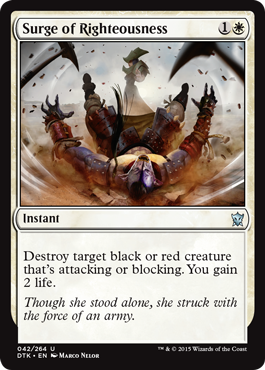
Surge of Righteousness is instant speed, which makes it a particularly great answer to the haste creatures that are so popular in the color red.
I think there's a tendency to look at something like "gain 2 life" as simply a small bonus tacked onto the effect of a card. In reality it's much, much, much more than that. Games of Magic are decided on thin margins, and these little advantages are what add up to determine a game. Without the 2 life, Surge of Righteousness would be a mediocre card, but with the 2 life it's really fantastic!
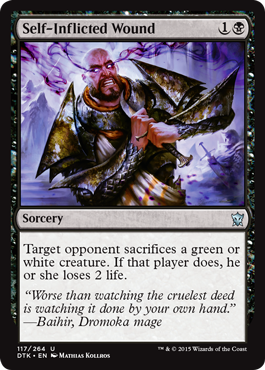
The same is true of Self-Inflicted Wound and the 2 points of life loss it inflicts on the opponent.
There's no shortage of good black removal in Standard, but there is a shortage of good black removal that costs less than three mana. Since the most dangerous weenie creatures in Standard are white and green, Self-Inflicted Wound will be a valuable sideboard tool, if not a main-deck consideration! Think of Warden of the First Tree, Rakshasa Deathdealer, Seeker of the Way, Soulfire Grandmaster, Sylvan Caryatid, and plenty more!
What makes me most excited about Self-Inflicted Wound is its ability to answer a monstrous Fleecemane Lion, which is a card that gives slow, removal-heavy decks nightmares.
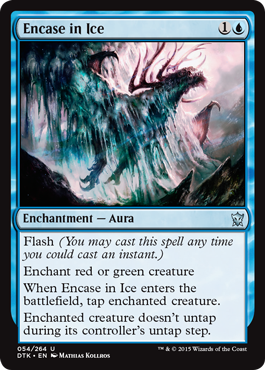
While not as flashy as the above two cards, Encase in Ice is special because blue has very few effective removal options. In a deck that might not have access to black removal, Encase in Ice is likely to be very important.
What's more, Encase is a way to stop a creature without sending it to the graveyard, which is invaluable against the annoying Ashcloud Phoenix and Flamewake Phoenix.
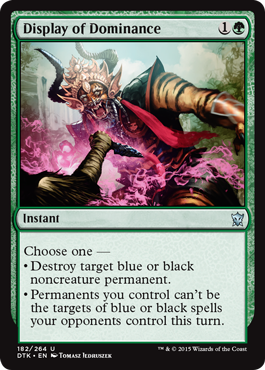
Last but not least, we have Display of Dominance, which is green's way of putting the kibosh on black-and-blue controlling decks. The most common use will be saving your creatures from removal, but the real value of the card is in its flexibility.
Green Devotion, as a deck with tons of creatures and few ways to destroy permanents, is very weak against Ashiok, Nightmare Weaver. Display of Dominance gives the deck a card that's generally useful but destroys Ashiok whenever you need it to!
Other great targets for Display of Dominance include Whip of Erebos and Kiora, the Crashing Wave.
As for the red version of this cycle? That's being previewed elsewhere later this week, so stay tuned...
What we didn't touch on is the strength of these color-hate cards in Limited. I can't say for sure without knowing more about Dragons of Tarkir, but I expect them to be high picks in Booster Draft, and perhaps to be considerations for main deck!
Pick them in Booster Draft, consider them for your Constructed sideboard. The key, as always, is to be thoughtful and consider your options ahead of time. It's always better to look at the big picture instead of muddling through your decisions one question at a time.
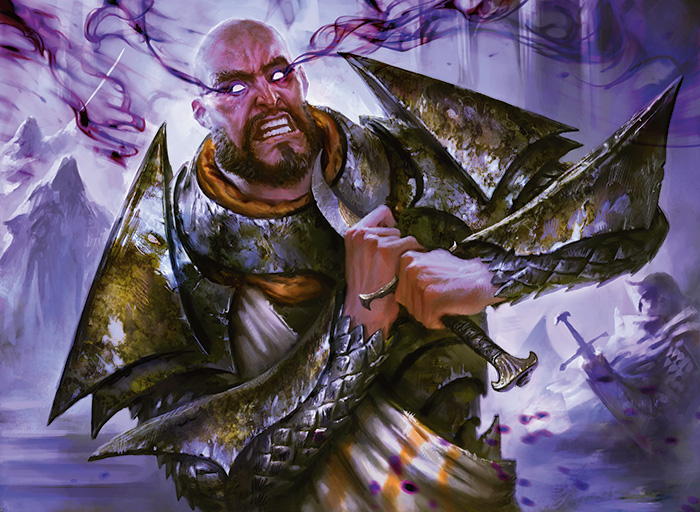
Self-Inflicted Wound | Art by Mathias Kollros

